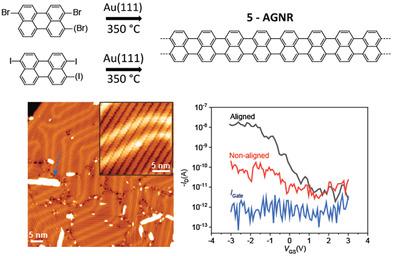Our official English website, www.x-mol.net, welcomes your feedback! (Note: you will need to create a separate account there.)
Growth Optimization and Device Integration of Narrow-Bandgap Graphene Nanoribbons
Small ( IF 13.3 ) Pub Date : 2022-06-17 , DOI: 10.1002/smll.202202301 Gabriela Borin Barin 1 , Qiang Sun 1 , Marco Di Giovannantonio 1 , Cheng-Zhuo Du 2 , Xiao-Ye Wang 2 , Juan Pablo Llinas 3 , Zafer Mutlu 3 , Yuxuan Lin 3 , Jan Wilhelm 4 , Jan Overbeck 1 , Colin Daniels 5 , Michael Lamparski 5 , Hafeesudeen Sahabudeen 6 , Mickael L Perrin 1 , José I Urgel 1 , Shantanu Mishra 1 , Amogh Kinikar 1 , Roland Widmer 1 , Samuel Stolz 1 , Max Bommert 1 , Carlo Pignedoli 1 , Xinliang Feng 6 , Michel Calame 1 , Klaus Müllen 7, 8 , Akimitsu Narita 7, 9 , Vincent Meunier 5 , Jeffrey Bokor 3 , Roman Fasel 1, 10 , Pascal Ruffieux 1
Small ( IF 13.3 ) Pub Date : 2022-06-17 , DOI: 10.1002/smll.202202301 Gabriela Borin Barin 1 , Qiang Sun 1 , Marco Di Giovannantonio 1 , Cheng-Zhuo Du 2 , Xiao-Ye Wang 2 , Juan Pablo Llinas 3 , Zafer Mutlu 3 , Yuxuan Lin 3 , Jan Wilhelm 4 , Jan Overbeck 1 , Colin Daniels 5 , Michael Lamparski 5 , Hafeesudeen Sahabudeen 6 , Mickael L Perrin 1 , José I Urgel 1 , Shantanu Mishra 1 , Amogh Kinikar 1 , Roland Widmer 1 , Samuel Stolz 1 , Max Bommert 1 , Carlo Pignedoli 1 , Xinliang Feng 6 , Michel Calame 1 , Klaus Müllen 7, 8 , Akimitsu Narita 7, 9 , Vincent Meunier 5 , Jeffrey Bokor 3 , Roman Fasel 1, 10 , Pascal Ruffieux 1
Affiliation

|
The electronic, optical, and magnetic properties of graphene nanoribbons (GNRs) can be engineered by controlling their edge structure and width with atomic precision through bottom-up fabrication based on molecular precursors. This approach offers a unique platform for all-carbon electronic devices but requires careful optimization of the growth conditions to match structural requirements for successful device integration, with GNR length being the most critical parameter. In this work, the growth, characterization, and device integration of 5-atom wide armchair GNRs (5-AGNRs) are studied, which are expected to have an optimal bandgap as active material in switching devices. 5-AGNRs are obtained via on-surface synthesis under ultrahigh vacuum conditions from Br- and I-substituted precursors. It is shown that the use of I-substituted precursors and the optimization of the initial precursor coverage quintupled the average 5-AGNR length. This significant length increase allowed the integration of 5-AGNRs into devices and the realization of the first field-effect transistor based on narrow bandgap AGNRs that shows switching behavior at room temperature. The study highlights that the optimized growth protocols can successfully bridge between the sub-nanometer scale, where atomic precision is needed to control the electronic properties, and the scale of tens of nanometers relevant for successful device integration of GNRs.
中文翻译:

窄带隙石墨烯纳米带的生长优化和器件集成
石墨烯纳米带 (GNR) 的电子、光学和磁性特性可以通过基于分子前体的自下而上制造以原子精度控制其边缘结构和宽度来设计。这种方法为全碳电子器件提供了一个独特的平台,但需要仔细优化生长条件以匹配成功器件集成的结构要求,其中 GNR 长度是最关键的参数。在这项工作中,研究了 5 原子宽扶手椅 GNR (5-AGNR) 的生长、表征和器件集成,预计其作为开关器件中的活性材料具有最佳带隙。5-AGNRs 是在超高真空条件下由 Br 和 I 取代的前体通过表面合成获得的。结果表明,使用 I 取代的前体和初始前体覆盖的优化使平均 5-AGNR 长度增加了五倍。这种显着的长度增加允许将 5-AGNR 集成到器件中,并实现了第一个基于窄带隙 AGNR 的场效应晶体管,该晶体管在室温下显示出开关行为。该研究强调,优化的生长协议可以成功地在亚纳米尺度(需要原子精度来控制电子特性)和与 GNR 的成功器件集成相关的数十纳米尺度之间架起桥梁。这种显着的长度增加允许将 5-AGNR 集成到器件中,并实现了第一个基于窄带隙 AGNR 的场效应晶体管,该晶体管在室温下显示出开关行为。该研究强调,优化的生长协议可以成功地在亚纳米尺度(需要原子精度来控制电子特性)和与 GNR 的成功器件集成相关的数十纳米尺度之间架起桥梁。这种显着的长度增加允许将 5-AGNR 集成到器件中,并实现了第一个基于窄带隙 AGNR 的场效应晶体管,该晶体管在室温下显示出开关行为。该研究强调,优化的生长协议可以成功地在亚纳米尺度(需要原子精度来控制电子特性)和与 GNR 的成功器件集成相关的数十纳米尺度之间架起桥梁。
更新日期:2022-06-17
中文翻译:

窄带隙石墨烯纳米带的生长优化和器件集成
石墨烯纳米带 (GNR) 的电子、光学和磁性特性可以通过基于分子前体的自下而上制造以原子精度控制其边缘结构和宽度来设计。这种方法为全碳电子器件提供了一个独特的平台,但需要仔细优化生长条件以匹配成功器件集成的结构要求,其中 GNR 长度是最关键的参数。在这项工作中,研究了 5 原子宽扶手椅 GNR (5-AGNR) 的生长、表征和器件集成,预计其作为开关器件中的活性材料具有最佳带隙。5-AGNRs 是在超高真空条件下由 Br 和 I 取代的前体通过表面合成获得的。结果表明,使用 I 取代的前体和初始前体覆盖的优化使平均 5-AGNR 长度增加了五倍。这种显着的长度增加允许将 5-AGNR 集成到器件中,并实现了第一个基于窄带隙 AGNR 的场效应晶体管,该晶体管在室温下显示出开关行为。该研究强调,优化的生长协议可以成功地在亚纳米尺度(需要原子精度来控制电子特性)和与 GNR 的成功器件集成相关的数十纳米尺度之间架起桥梁。这种显着的长度增加允许将 5-AGNR 集成到器件中,并实现了第一个基于窄带隙 AGNR 的场效应晶体管,该晶体管在室温下显示出开关行为。该研究强调,优化的生长协议可以成功地在亚纳米尺度(需要原子精度来控制电子特性)和与 GNR 的成功器件集成相关的数十纳米尺度之间架起桥梁。这种显着的长度增加允许将 5-AGNR 集成到器件中,并实现了第一个基于窄带隙 AGNR 的场效应晶体管,该晶体管在室温下显示出开关行为。该研究强调,优化的生长协议可以成功地在亚纳米尺度(需要原子精度来控制电子特性)和与 GNR 的成功器件集成相关的数十纳米尺度之间架起桥梁。


























 京公网安备 11010802027423号
京公网安备 11010802027423号